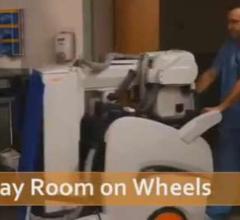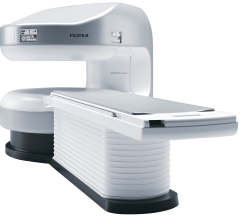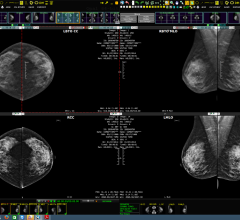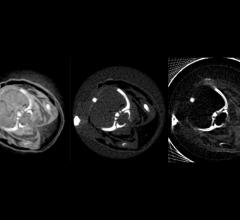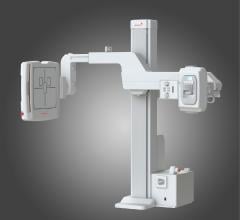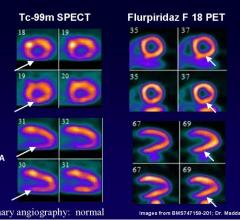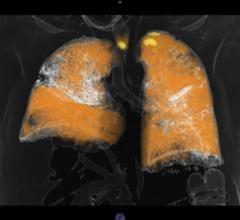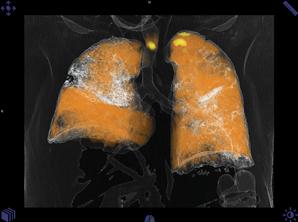The Organization for Occupational Safety in Interventional Fluoroscopy (ORSIF) announced the release of a new documentary film on the impact of chronic, low-level exposure to ionizing radiation on physicians that practice interventional medicine in fluoroscopy labs. The documentary features noted heart surgeon Edward Diethrich, M.D., founder of the Arizona Heart Foundation.
Leksell Radiosurgery Award winner Deborah C. Marshall presented her research, “Survival Patterns of Patients with Cerebral Metastases after Multiple Rounds of Stereotactic Radiosurgery” (SRS), at the 2015 American Association of Neurological Surgeons Annual Scientific Meeting.
Fujifilm’s APERTO Lucent is a 0.4T mid-field, open MRI system addressing today’s capability and image quality needs ...
Viztek will showcase its new Exa Mammo Viewer during this year’s Society for Imaging Informatics in Medicine (SIIM) conference, May 28-30 in Washington, D.C.
Soft tissue disorders like tumors are very difficult to recognize using normal X-ray machines. There is hardly any distinction between healthy tissue and tumors. Researchers at the Technische Universität München (TUM) have now developed a technology using a compact synchrotron source that measures not only X-ray absorption, but also phase shifts and scattering. Tissue that is hardly recognizable using traditional X-ray machines is now visible.

SPONSORED CONTENT — Fujifilm’s latest CT technology brings exceptional image quality to a compact and user- and patient ...
Ackerman Cancer Center in Jacksonville, Florida, treated its first four proton therapy patients at the end of April, becoming the first private, physician-owned practice to offer this advanced form of radiation therapy. Within the first week of operation with the new system — a Mevion S250 — eight patients began proton therapy, with cancers affecting the parotid (salivary gland), prostate, tongue and base of the skull.
SPONSORED CONTENT — Fujifilm’s latest CT technology brings exceptional image quality to a compact and user- and patient ...
New research, published in the journal Radiology, suggests some types of a popular contrast agent used in magnetic resonance imaging (MRI) exams may remain in the brain for years, but that the long-term effects are unknown.
Rayence Inc. announced that the RU-3000 Digital Universal Radiography System has received 510(k) clearance from the U.S. Food and Drug Administration (FDA). The RU-3000 is the first U-arm system to be marketed by Rayence in the United States. Its small footprint and compact design allows for easy installation, and its dual telescoping arm movement permits installation in settings having ceiling heights of just 8 feet.
In response to the proposed mammography guidelines from the U.S. Preventive Services Task Force (USPSTF), Strategic Radiology (SR) recommends regular screening mammography for women beginning at age 40 in order to reduce breast cancer mortality. SR joins other organizations — including the American Congress of Obstetricians and Gynecologists (ACOG), the American College Of Surgeons, Susan G. Komen for the Cure, American Cancer Society (ACS), American College of Radiology (ACR) and Society of Breast Imaging (SBI) — in speaking out against the USPSTF guidelines.
SPONSORED CONTENT — EnsightTM 2.0 is the newest version of Enlitic’s data standardization software framework. Ensight is ...
Carestream showcased the advanced interoperability of its Clinical Collaboration Platform (CCP) at the IHE-Europe (Integrating the Healthcare Enterprise) Connectathon held April 20-24 in Luxembourg. Carestream announced that the CCP product suite successfully passed all integration tests at the Connectathon including all profiles for its universal viewer, vendor-neutral archive (VNA) and image capture solutions. Carestream is also among the first VNA suppliers to implement HL7's new Fast Healthcare Interoperability Resources (FHIR) framework.
vRad (Virtual Radiologic) announced that it ranked No. 49 on 2015’s InformationWeek Elite 100, a list of top business-technology innovators in the United States. The company was ranked No. 9 amongst those winners in the Healthcare industry.
Konica Minolta Medical Imaging Americas announced it has achieved record sales growth for fiscal year ended March 31, 2015, led by sales of their digital radiography family. The success of the wireless Konica Minolta AeroDR panel fueled company growth to double-digit sales figures, exceeding expectations. The AeroDR family of digital radiography solutions includes the AeroDR XE, a wireless flat panel detector specially engineered. The Primary Imaging Solutions also includes the Sonimage ultrasound family.
Did you know that approximately one-third of all the data in world is created by the healthcare industry and that ...
Research firm KLAS released a new report on electronic medical record (EMR) usability and product performance over the past two years, revealing how physicians and other users rate various vendors and solutions. The report, entitled “Physician Leadership Weighs In on Acute Care EMR Usability” compares usability performance in the acute care EMR market segment.
Viztek announced the availability of the Basic U-Arm, a new U-Arm digital X-ray system. Ideal for urgent care and orthopedic settings, among others, the system combines the benefits of a typical U-Arm system at an affordable entry point for many facilities.
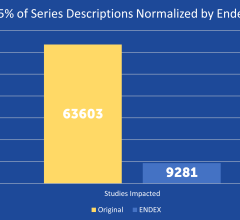
SPONSORED CONTENT — EnsightTM 2.0 is the newest version of Enlitic’s data standardization software framework. Ensight is ...
Kubtec recently named new regional sales managers for the global markets. The appointments were made to meet the rising demand for Kubtec‘s products worldwide, including Mozart with TomoSpec, a specimen tomosynthesis system for excised breast tissue, and KUB 250, a high-resolution, low-dose portable digital X-ray system dedicated for neonatal imaging.
Results from Lantheus Medical Imaging Inc.’s first Phase 3 study of flurpiridaz F 18 for myocardial perfusion imaging (MPI) were presented at the International Conference on Nuclear Cardiology and Cardiac CT (ICNC12) in Madrid, Spain. The oral presentation was made by Jamshid Maddahi, M.D., professor of medicine (cardiology) and molecular & medical pharmacology (nuclear medicine), David Geffen School of Medicine at UCLA, in the “Important Clinical Trials and Registries in Nuclear Cardiology” session of ICNC12.
The diagnostic radiology department of LLUMC conducts an average of 500 diagnostic exams for roughly 1,600 images per day. It was clear that transitioning from CR to DR would have significant positive impact on patient care. However, without the availability of sufficient capital to fund this transition, moving to DR did not appear to be a current possibility, but instead it would need to be a future goal. The radiology department was left with the challenge of trying to find a way to implement a DR an upgrade that they knew would save the hospital vast amounts of money in the long-run without the availability of a large up-front capital investment to purchase and install the new equipment. LLUMC turned to Agfa HealthCare to find a solution to this major challenge. The answer came in the form of Agfa HealthCare’s Fast Forward DR Upgrade Program, which was designed to allow hospitals to keep up with the fast-paced evolution in X-ray technology even in the absence of immediate capital funds. The program allows healthcare providers to sustain their existing financial model and upgrade to the best X-ray technology available with a cost structure that allows the transition to pay for itself.
A battle is taking shape in computed tomography (CT), one that pits the tubes that deliver X-rays against the detectors that record them. It is a fight over how to use X-rays of different energies — variations on the decades-old concept of selective energy CT (SECT), which promise to make diagnoses more accurate and patient management more effective.
A battle is taking shape in computed tomography (CT), one that pits the tubes that deliver X-rays against the detectors that record them. It is a fight over how to use X-rays of different energies — variations on the decades-old concept of selective energy CT (SECT), which promise to make diagnoses more accurate and patient management more effective.
Breast cancer screening has been on the forefront with the issue of breast density taking center stage. However, controversy surrounds the many contradicting studies that currently dictate the standards for breast cancer screening.

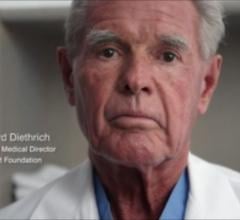
 May 07, 2015
May 07, 2015 

